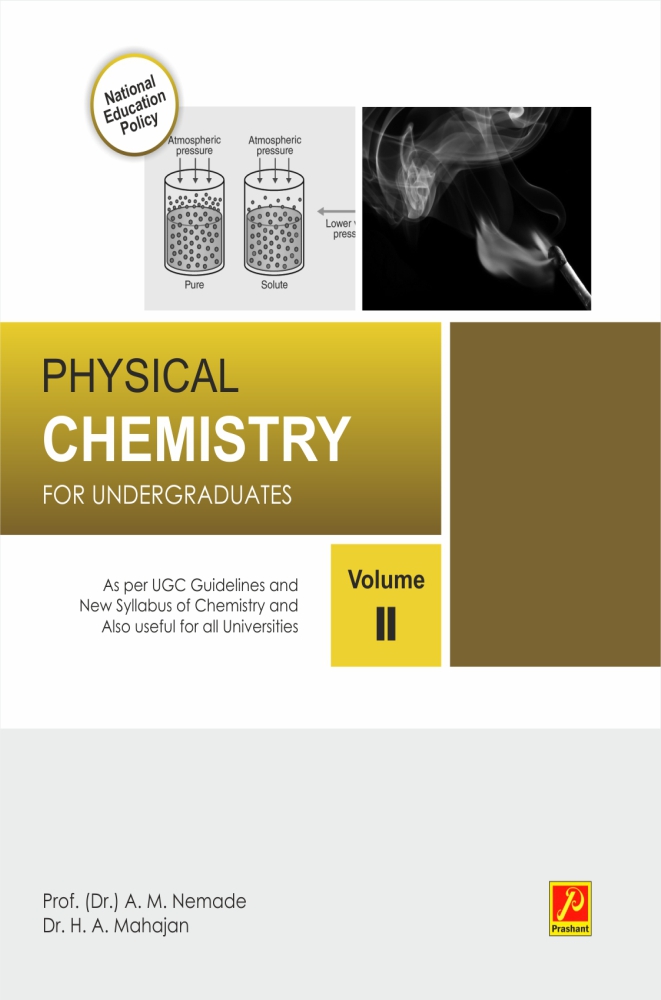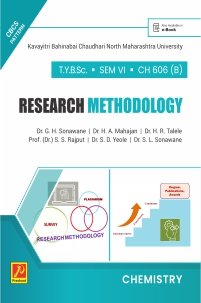Physical Chemistry for Undergraduates
(Volume II)
Authors:
ISBN:
Rs.650.00
- DESCRIPTION
- INDEX
We are pleased to present the book on Physical Chemistry Vol. (II) in the hands of students learning Physical Chemistry at Undergraduate level and the teachers of Physical Chemistry. The book is written by keeping in mind the curriculum of Physical Chemistry prescribed by UGC that should be taught at different levels through various papers under the NEP. Physical Chemistry is the fundamental part of curriculum of chemistry. Hence there is need of understanding it from very basics.
The book focuses on understanding the terms and principle involved in Physical Chemistry. The book aims to explain fundamental aspects of Physical Chemistry with simple examples. The content of this book attempts to clarify the basic knowledge of the subject without going through exhaustive details.
In this book of Physical Chemistry, we have tried to cover some topics which are not covered in Vol (I). while some topic such as Solution and its Properties are repeated to understand the subject deeply. In this volume the Advance Physical Chemistry topics are included such as Phase Rule, Chemical Kinetics, Photo Chemistry, Basics of Molecular Spectroscopy, Radioactivity and its Applications, Catalysis and Basic Quantum Chemistry
However, to develop interest of learners, labelled diagrams and solved numerical are given wherever necessary.
This book is written in very simple language and unnecessary explanation is avoided. It will definitely generate interest of the learner in understanding of the subject. We hope this book will be useful for the undergraduate students of chemistry.
1. Solution
1.1 Solubility 1.2. Types of Solution 1.3. Different way of expressing the concentration of solution 1.4 Vapour Pressure 1.5 Raoul’s law and its limitation 1.6 Ideal and non-ideal solutions (Solutions of Liquids in Liquids) 1.7. The vapour pressure of actual liquid pairs 1.8 Vapour pressure liquid and vapour pressure vapour composition curves of solution (VP digram of miscible binary mixture) 1.9 Fractional distiliation 1.10 Boiling point digrams of miscible binary mixture (P-X and T-X Diagram) 1.11. Distillation of binary miscible solutions 1.12. Azeotropes 1.13. Fractionating column 1.14 Solubility of partially miscible liquid pairs.
2. Colligative Properties
2.1 Colligative Properties 2.2 Lowering of Vapour Pressure of Solvent 2.3 Boiling Point Elevation of Solution 2.4. Freezing Point Depression of Solution 2.5 Osmosis and Osmotic Pressure 2.6. Solution of Electrolytes
2.7. Colligative Properties of Electrolytes 2.8. Abnormal Molecular Weight.
3. Chemical Thermodynamics
3.1. Spontaneous and Non – Spontaneous processes 3.2. Second law of Thermodynamics 3.3 Entropy – (S) 3.4. Entropy change an isolated system 3.5. Statement of Second law based on Entropy 3.6. Physical significance of entropy 3.7. Entropy changes for systems only 3.8. Entropy changes in Ideal gases 3.9. Entropy change in Physical Transformation 3.10 Entropy change during heating of solids, liquids and gases
4. Basic Electrochemistry
4.1. Some Basic Terms Involved in Electrochemistry 4.2. Electromotive Force and its Measurement 4.3 Standard cell 4.4 Cell Reaction and EMF 4.5 Convention Regarding Sign of EMF 4.6 Single Electrode Potential 4.7 Calculation of Single Electrode Potentials 4.8 Thermodynamics and EMF 4.9. Nernst Equation 4.10. Standard Potentials and Equilibrium Constant 4.11 Classification of Electrodes
5. Electrochemical Cell and Its Applications
5.1 Liquid Junction Potential 5.2. Electrochemical cells 5.3. Chemical Cell without transfernce (Without Porous Partition) 5.4 Chemical cell with transference (Presence liquid junction potential) 5.5 Concentration Cells 5.6. Expression For Liquid Junction Potential (The Junction Potential) 5.7. Applications of EMF Measurements 5.8. Potentiometric titration.
6. Photochemistry
6.1 Photochemical reaction and Thermo chemical reaction 6.2 Laws of Photochemistry 6.3. Quantum Yield or Quantum Efficiency () 6.4. Consequence of light absorption by atom and molecules 6.5. Consequences of light absorption by atoms 6.6. Experimental Study of Photochemical Reaction 6.7. Photochemical Gas Reactions 6.8. Photosensitized Gas Rections 6.9. Chemiluminescence.
7. Chemical Kinetics
7.1. Rate of reaction 7.2. Rate law and Rate constant (Velocity constant)
7.3. Measurement of reaction rate 7.4. Factors affecting the reaction rates
7.5. Order and molecularity of a reaction 7.6. First order reaction 7.7. Second order reactions 7.8. Characterstics of second order reaction 7.9. Third order reaction 7.10. Pesudomolecular reactions 7.11. Determination of order of reaction 7.12. Effect of temperature on reaction rate 7.13. Arrhenius Equation 7.14. Energy of activation.
8. Phase Rule
8.1 Definitions 8.2 Terms involved in Phase Rule 8.3 Phase Rule 8.4 One component system 8.5 Water system 8.6 Sulphur System 8.7 Two component system 8.8. Three Component System.
9. Molecular Spectroscopy
9.1. Molar volume 9.2. Refractive index 9.3. Refractivity (r) 9.4. Optical exaltation 9.5. Molar refraction of solids 9.6. Dipole moment of molecule 9.7. Polarisability of the molecule (Electric polarization of molecules) 9.8. Measurement of dipole moment 9.9. The Dipole moment and Molecular structure 9.10. Molecular spectroscopy 9.11. Characterisation of electromagnetic radiation 9.12. Quantisation of energy 9.13. Energy Levels 9.14. Regions of the spectrum 9.15. Types of spectra 9.16. Rotational spectroscopy (Microwave spectroscopy) 9.17. Rotational spectra of rigid diatamic molecule 9.18. Isotopic substitution effect on rotational spectra 9.19. Mathematical interpretation of rotational spectra of CO and HCl.
10. Radioactivity and Its Applications
10.1 Classification of nuclides 10.2 Radioactivity 10.3 Radioactive Elements 10.4 General characterstic of radioactive decay 10.5 Decay kinetics 10.6 Half life period 10.7 Units of Radioactivity 10.8 – decay 10.9 Geiger-Nuttal’s Law 10.10. Beta decay 10.11 Measurement of Radioactivity 10.12 Counting devices 10.13 Application of radioactivity 10.14 Applications of radioisotopes in age determination 10.15 Medical applications.
11. Elementary Quantum Mechanics
11.1. Black body radiation 11.2. Plank’s law of radiation 11.3. Photo electric effect 11.4. Compton effect 11.5. Wave particle duality of material particles and deBroglie’s Hypothesis 11.6. The Heisenberg’s uncertainty principle
11.7. Interpretation of wave function 11.8. Operators in quantum mechanics 11.9. Postulate of quantum mechanics.
12. Surface Phenomenon and Catalysis
12.1. Adsorption and absorption 12.2 Adsorption of gases by solids 12.3 Types of Adsorption 12.4 Difference between Physical and Chemical adsorption 12.5 Adsorption Isotherm 12.6 Freundilich Adsorption Isotherm 12.7 Langmuir Adsorption Isotherms 12.8 Adsorption of solute by solids 12.9 Applications of Adsorption 12.10 Catalysis of gaseous reactions by solid surfaces 12.11 Kinetics of heterogeneous reactions 12.12. Retarded reactions 12.13 Catalytic Poisons.
13. Solid State
13.1. Introduction 13.2.Crystallization and Fusion 13.3. Crystallography 13.4. The Crystal Systems 13.5. Prtoperties of Crystals 13.6. The Structure of Crystals 13.7. X–rays 13.8. The Bragg Method of Crystal Analysis 13.9. Bragg’s X-ray Spectrometer 13.10. The X-ray Analysis of Sodium Chloride 13.11. Positions of Sodium Chloride atoms in NaCl lattice13.12. Calculation of interplane distance (d) and Wavelength () 13.13. Number of molecules in unit lattice 13.14. Powder method of crystal analysis 13.15. Semiconducters 13.16. Solar Cell 13.17. Liquid crystal.
Author
Related products
-
A Textbook of Physical Chemistry
Rs.350.00









